7.5 Three Ways to Organize the Biosphere
Describe three approaches to organizing the biosphere.
The biosphere is the most complex of Earth’s physical systems. This section explores three major approaches to organizing the biosphere that also reveal how it functions. There are three main ways of categorizing life on Earth: the trophic hierarchy, the taxonomic hierarchy, and the spatial hierarchy.
The Trophic Hierarchy
The first approach to organizing the biosphere is based on the movement of energy and matter through it, beginning with solar energy. Photosynthesis is the gateway through which solar energy enters the biosphere. The process of photosynthesis converts solar radiant energy to chemical energy that is stored as sugars, as shown in Figure 7.23.
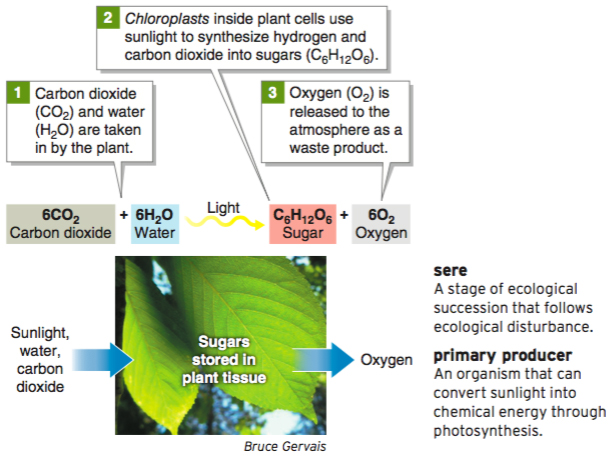
Figure 7.23
A primary producer is any organism that is able to convert sunlight to chemical energy through photosynthesis. On land, most primary producers are plants. In freshwater bodies and in the oceans, the primary producers are phytoplankton, microscopic algae and plantlike bacteria called cyanobacteria. Phytoplankton are microscopic bacteria and algae that are suspended in the sunlit portions of water and photosynthesize.
sere
A stage of ecological succession that follows ecological disturbance.
primary producer
An organism that can convert sunlight into chemical energy through photosynthesis.
phytoplankton
Microscopic bacteria and algae that are suspended in the sunlit portions of water and photosynthesize.
242
Photosynthesis does not truly produce energy. Instead, it converts energy from one form (radiant energy) to another (chemical energy). Of the total solar energy falling on a photosynthetic organism, less than 5% is converted to chemical energy through photosynthesis. This chemical energy is then transferred from the photosynthetic organisms to consumers. A consumer is any organism that cannot produce its own food through photosynthesis. As consumers eat primary producers, and as they are eaten in turn by other consumers, the solar energy made available by the primary producers flows through a food chain (Figure 7.24).
consumer
An organism that cannot produce its own food through photosynthesis.
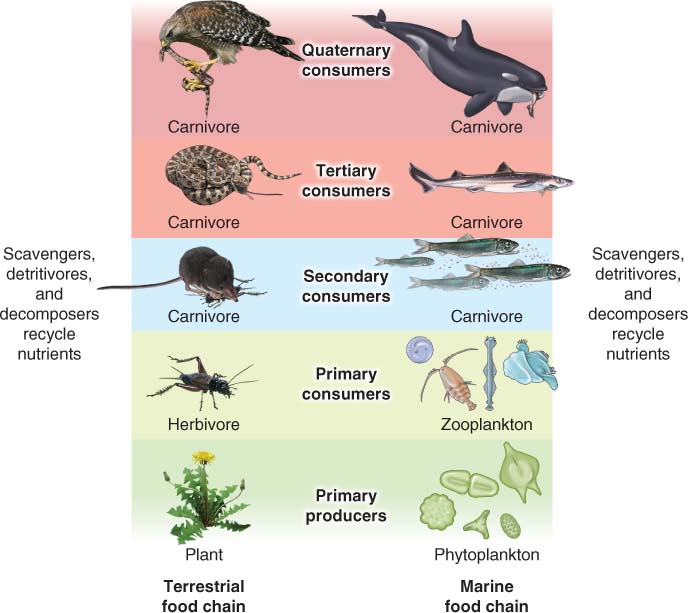
Figure 7.24
Food chains are composed of herbivores, organisms that eat only primary producers; carnivores, organisms that eat only other consumers; and omnivores, organisms that eat both primary producers and other consumers. Herbivores such as grasshoppers are called primary consumers because they eat plants directly. A mouse that eats a grasshopper is a secondary consumer, a snake that eats the mouse is a tertiary consumer, and so on.
herbivore
An organism that eats only plants.
omnivore
An organism that eats both plants and animals.
When an organism dies, its tissues are recycled by scavengers, detritivores, and decomposers. The biosphere would have long ago run out of organic material to metabolize if not for the work of these organisms. Scavengers are animals such as coyotes and vultures that feed on carrion (dead animals). Many animals are at least part-
decomposer
An organism that breaks organic material down into simple compounds.
The food chain concept is a good starting point but in nature, energy and matter do not flow in straight paths. Instead, the movements of energy and matter through the biosphere form complex systems of ecological interconnections called food webs. The different levels of an ecosystem through which energy and matter flow are called trophic levels.
food web
The ecological interconnections among organisms occupying different trophic levels.
trophic level
One of the levels of an ecosystem through which energy and matter flow.
Plants form the base of terrestrial trophic levels. Their chemical energy passes to consumers at higher trophic levels. With each higher trophic level, only about 10% of available energy is passed on. The remainder either is not absorbed by the consumer’s body or is lost as heat. This phenomenon of energy loss is approximated as the 10% rule (Figure 7.25).
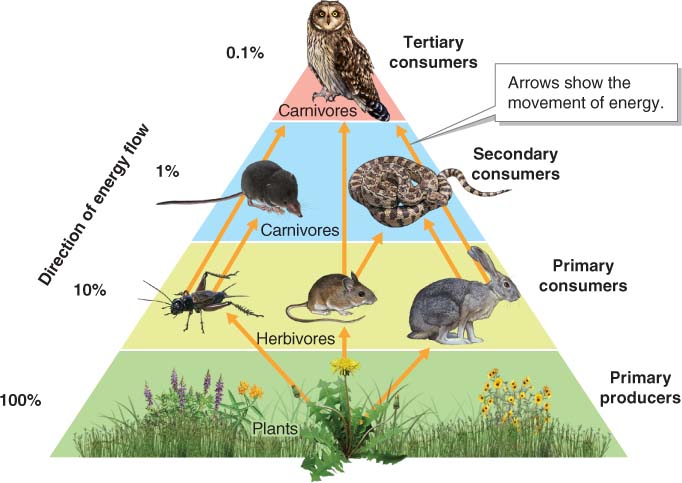
Figure 7.25
243
The 10% rule can apply to biomass (the dried weight of living material) as well as to energy. Because of this loss of energy at successive trophic levels, there is a rapid diminishment in biomass with each trophic level. Populations of top predators (such as wolves and owls) typically have very low total biomass compared with the trophic levels below them. In Crunch the Numbers, you will calculate how much biomass at the primary producer level is necessary to support one owl that weighs 0.5 kg (1.1 lb).
biomass
The dried weight of living material.
Many organisms occupy more than one trophic level. Bears, for example, can be scavengers when they eat carrion, herbivores when they eat berries, and carnivores when they eat insects. This makes them omnivores. Picture This shows an organism that defies conventional trophic categorization.
The Taxonomic Hierarchy
The second way of organizing the biosphere is based on the genetic relationships among organisms. Taxonomy is the classification and naming of organisms based on their genetic similarities. Taxonomy has two main goals: (1) to assign a unique name to every known species, and (2) to reveal genetic relationships among organisms.
taxonomy
The classification and naming of organisms based on their genetic similarities.
How Scientific Names Work
You may have noticed in this chapter that when a specific organism is named, its common name and its scientific name are given. The scientific name is given in parentheses. Scientists give every known species on Earth a unique scientific name that consists of a genus name and a species name.
Humans, for example, are Homo sapiens. Homo in Latin means “person,” and sapiens means “wise.” Homo is the genus name and sapiens is the name for our species. It might help to think of the genus as a car make, such as “Honda.” Just as there can be many car models within a car make (such as “Honda Civic,” “Honda Accord,” and so on), there can be many species within a genus. This naming system, which was first developed by the Swedish naturalist Carl Linnaeus (1707–
Picture This
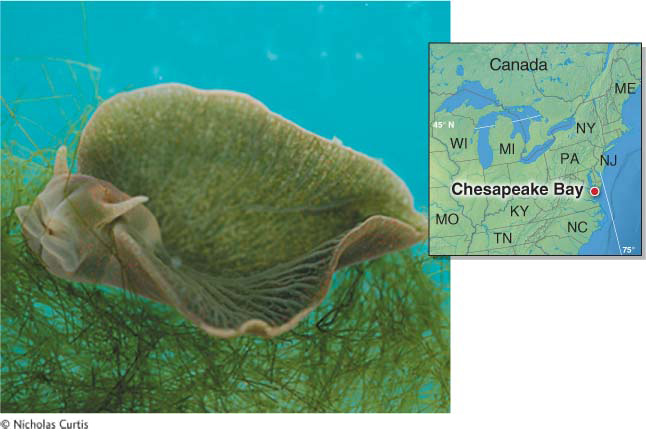
A Photosynthetic Slug: Plant or Animal?
The eastern emerald elysia (Elysia chlorotica) is a sea slug that is about 3 cm (1.2 in) long. It does something animals do not normally do—
Consider This
Question 7.6
zlDcJsQENwFczoVwomcgxmlPxqbCHbbjxzWeU0sd5b+Mj1vkTYdNhSpADSS1E6cb1fTTwCQ46l7NN+GGzeR+vtQ2W6Y=Question 7.7
sVKFGajAK877c8wLAMfzjLhXoXfTORC9uXEh+YTi5sjBRNMIy6dXCgg1T00MPcsVcD0e5W5S5OMIxYq2
CRUNCH THE NUMBERS: Calculating Biomass
CRUNCH THE NUMBERS: Calculating Biomass
Calculate the primary producer biomass necessary to support a 0.5 kg (1.1 lb) owl.
Question 7.8
ksosdnGMTSh0aX6ozi1DdW7lF4CgUFW0B1D6oY1ai4aTOBa5+RBX1f/lNuJc7oyT1nlME1/gGvfVHth31WdiISqU1WdMrsv/elEYdYQsePyahtQB0HV5LkVbY3WSY5jdG80yP3ClqEDrLqhj76UDgLypOQmfdB1gKd6aj/ZXwMC4fP7/NwJFDg/gG8ljAz31KmxCR8MZqoVF7wLKXk5LeUFQ8MxEUrhEaBPj0yMlepu/4gSpGUDV8I9zBy2I8p5urGee5XkIklmqz2dhfomuhH38xbN/226D4jxFKN7iQx5Wcae3zw5Ciln9zX4nwoInTLDU/4UV6INuCB7hg+keEFDBXuN0ylJznz/yx1LA5NAoNVWdYiJQgSBfSLjHaRVqUqs4tNGd7qTkJcqGIPvqRnC+siKpvv4+uT6XTF4r8v/OCP/M+JVrj75jQoU=Question 7.9
J9YIEvc60ZAoEDKhILNC3rN93fUJo4sOVYgq7OJ4CW3og5ejIZ2Fbt2KDau6Sk/nRqXqzDnKwdWC0d7dYpuoG7FsrIlAdIawjuiUGX4oELL5gkez+y5R0yTzMG0u2K09lFCHMjbb0Ybaudhi/1PmGg==Question 7.10
yI9qcDRoYcYhK9HhDOc3dRHzTJ9mJuyVuHLk5w63+NOO89T+MXfBdkTb8CBG9QYVK1kCw7D+KANcWwza7+zA2eguQULhcqe7FjGyi0u7mCs=
244
The taxonomic hierarchy consists of a series of nested groups. Each group belongs to another, larger group, in the same way folders are nested within one another in a computer or cell phone operating environment (Figure 7.26). Each family has at least one genus, and each genus has at least one species.

Figure 7.26
The taxonomic system uses homologous traits to group organisms that are genetically related to one another because they share a close common ancestor. For example, all birds have feathers, a characteristic that is unique to the class Aves. From ostriches to parrots to hawks—
Many related organisms do not look alike. For example, a cow, a bat, and a whale do not look alike, but they are genetically similar. They all have hair, and they all feed their young milk from mammary glands. Only mammals have these features.
Through convergent evolution (see Section 7.1), organisms sometimes look deceptively alike but have no close genetic ties. Such superficial resemblances between organisms are called analogous traits (Figure 7.27). Analogous traits do not reflect genetic similarities and are never used in taxonomic groupings. It would be misleading to group such organisms together because such a grouping would not reveal genetic relationships, one of the goals of taxonomy.

Figure 7.27
Common Names and Scientific Names
Common names and scientific names have different uses. A common name is a local name for an organism. Common names are useful because they are familiar. A problem with them is that there is often more than one common name per species. The “black bear,” for instance, is also called “North American black bear,” “American black bear,” and “cinnamon bear,” depending on where in North America you live. The Linnaean system assigns only one scientific name to each species. The scientific name for the black bear is Ursus americanus. Ursus means “bear” in Latin and americanus describes where it lives. There is only one Ursus americanus.
The Spatial Hierarchy
The third way of organizing the biosphere is based on the ecological units of life. The spatial hierarchy identifies units of life that range from the individual to the entire biosphere. The individual organism is the most localized unit of the spatial hierarchy. The whole biosphere is the largest unit in this categorization scheme, as shown in Figure 7.28.

Figure 7.28
245
Individuals make up populations of organisms, and populations form communities. A community consists of the populations of organisms interacting in a geographic area. Communities are named after their most conspicuous feature, by their geographic setting, or by the niche of the most prominent organisms living in them (Figure 7.29).
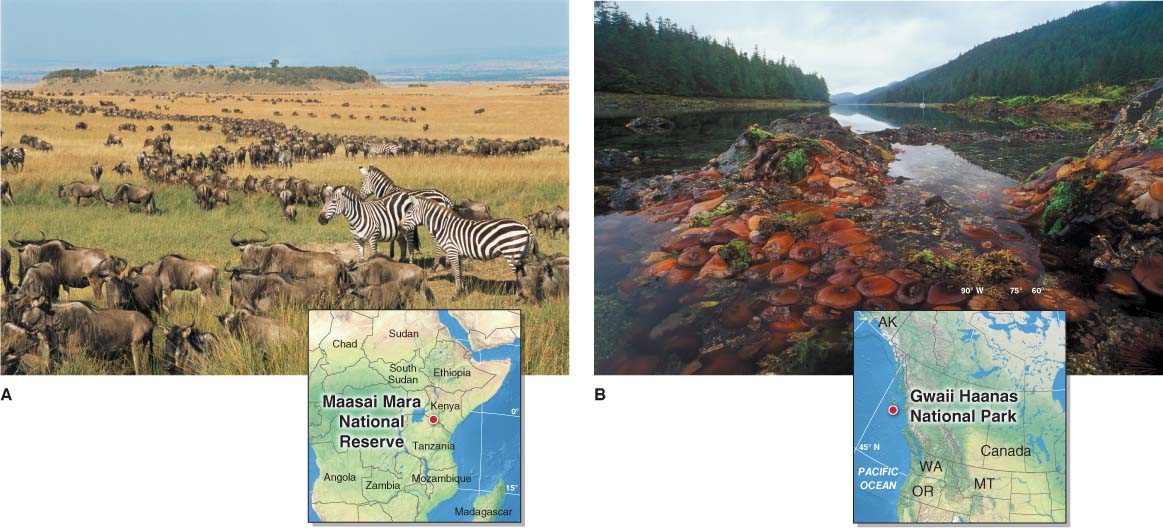
Figure 7.29
community
The populations of organisms interacting in a geographic area.
As we have seen, a community and its physical environment constitute an ecosystem. The ecosystem concept emphasizes the interconnectivity and interdependence of all facets of a landscape, both living and nonliving, including chemicals and nutrients. Many chemicals that are essential components of living organisms cycle through ecosystems. Oxygen, water, phosphorus, and potassium are just a few. Figure 7.30, on the next page, traces the nitrogen cycle and the carbon cycle to illustrate how these chemicals move through ecosystems.
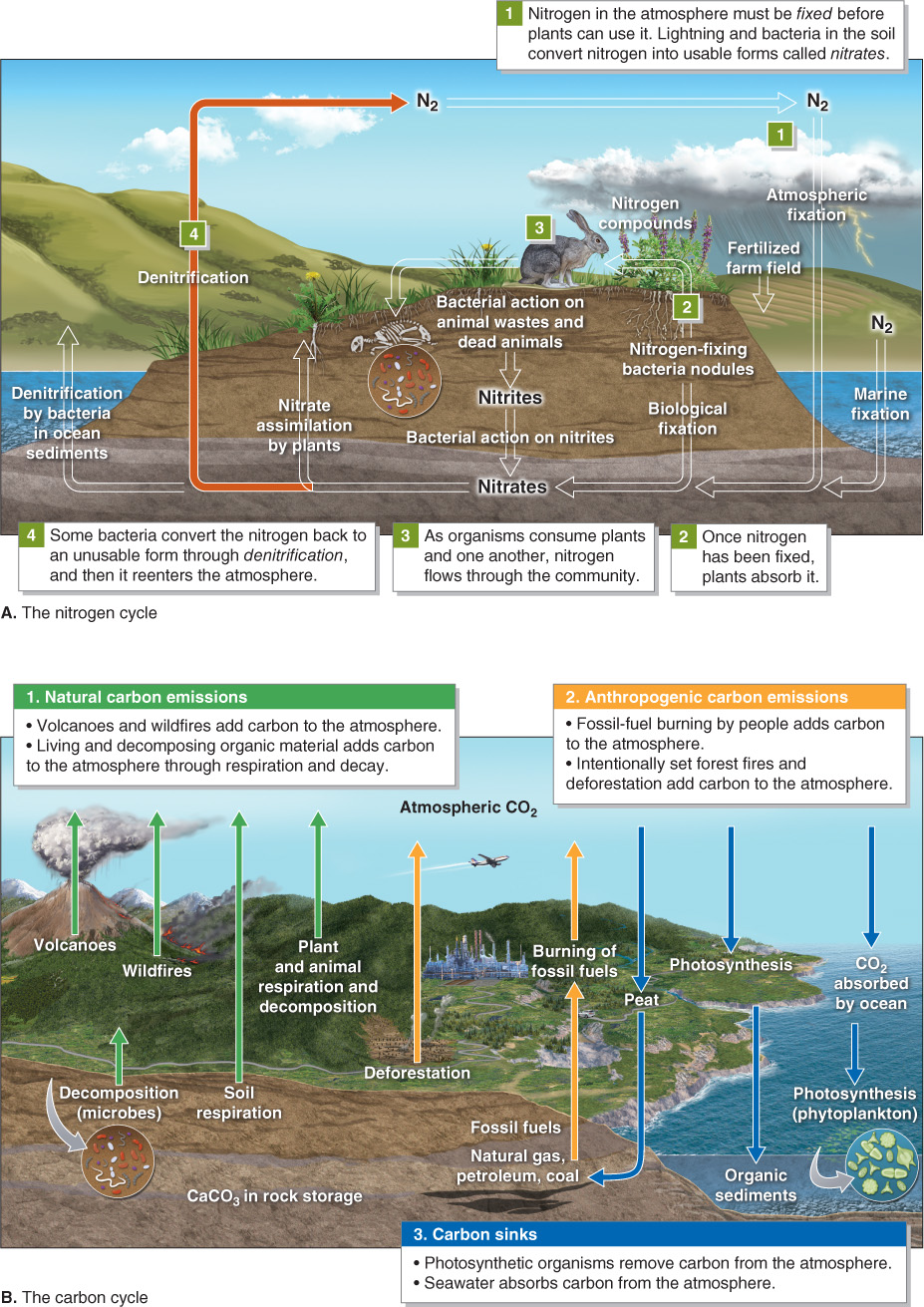
Figure 7.30
The last category of the spatial hierarchy is the biome. Earth’s biomes are geographically extensive. Only the biosphere is greater in spatial extent. Biomes are extensive expanses of vegetation types that are determined by climate. They will be the focus of the next chapter.
246
247